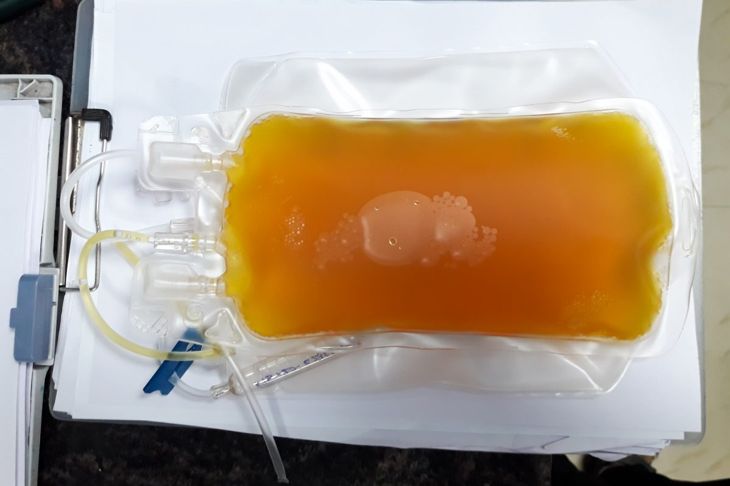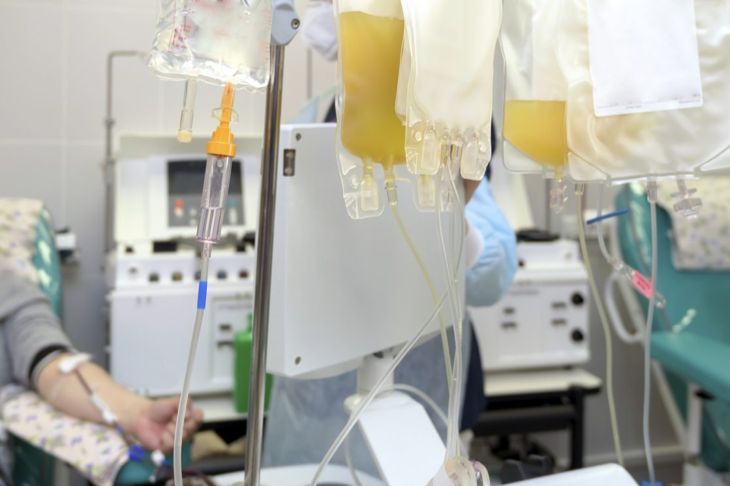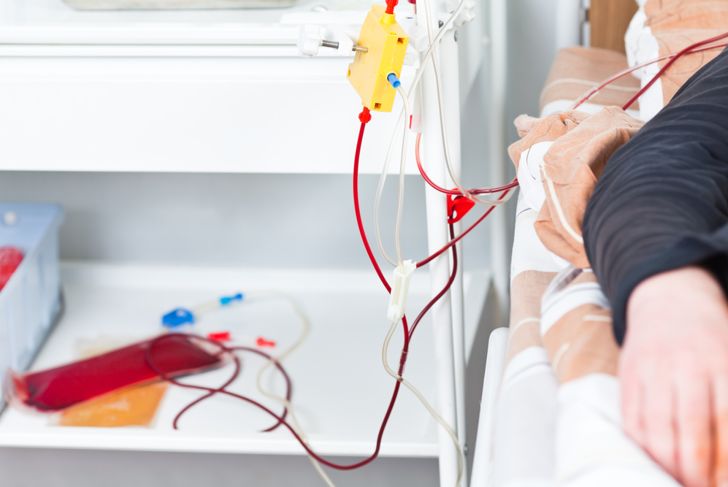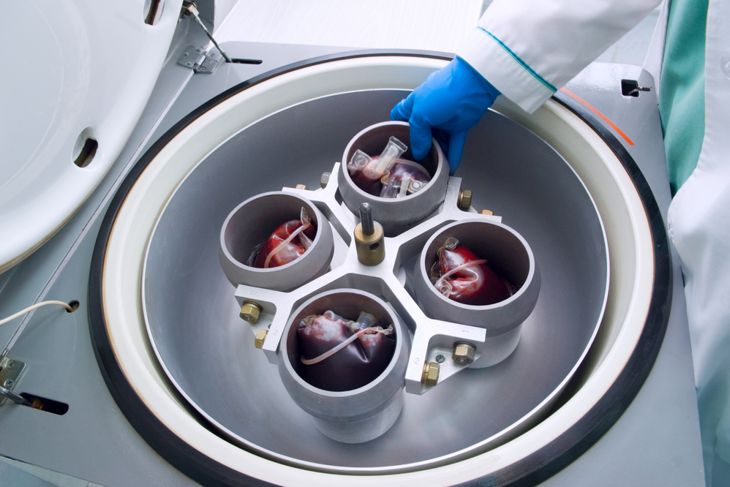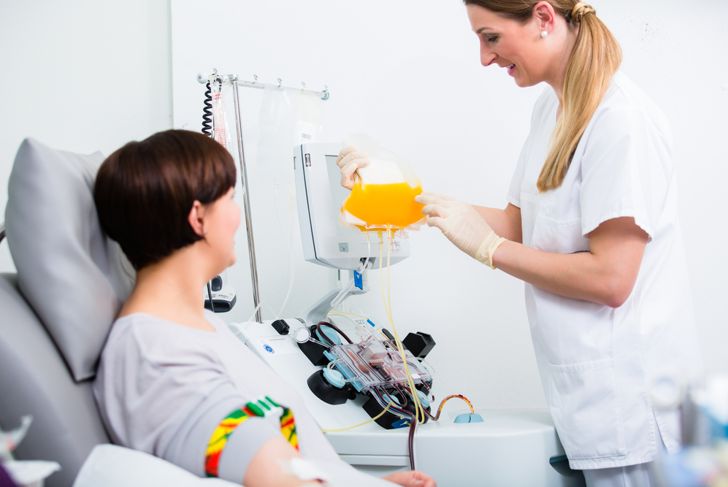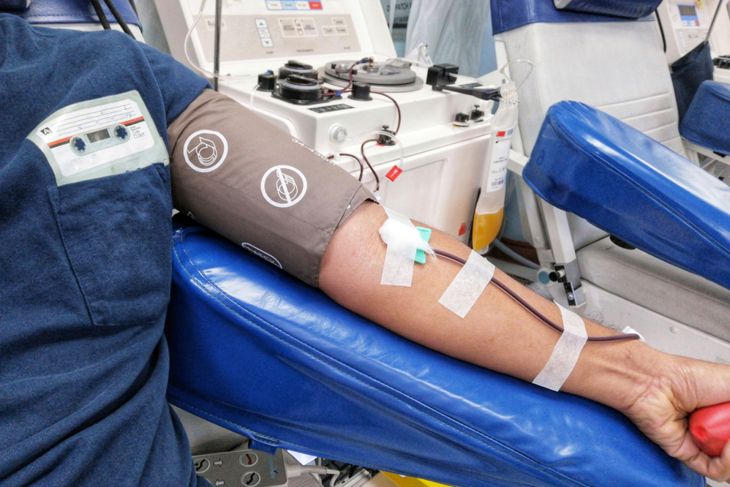Plasmapheresis is the process of separating plasma, the liquid part of blood, from other blood components. This procedure is done on healthy people when they donate plasma, but since such a small amount is removed, no replacement is necessary. When plasmapheresis is therapeutic, the process removes substances from the blood that are causing harm. The treatment requires the removal of large volumes of plasma, and the patient often receives donated plasma in exchange.
Role of Plasma
Plasma is the liquid part of the blood. It makes up about 55 percent of the total blood volume and is made up of salts, proteins, and water absorbed in the GI tract. Plasma helps with clotting, removing waste products, regulating body temperature, and maintaining the acid-base balance. It also protects against bacteria and viruses, transports nutrients, and carries oxygen. Physicians must consider all of these factors when determining whether a patient is eligible for plasmapheresis.
The Process
Plasmapheresis requires two large-bore IV catheters. Blood is removed through one of the catheters and circulated through a machine that separates the plasma. The patient’s plasma is collected and discarded while the second catheter returns the other components of the blood and a plasma replacement. An albumin solution or donor plasma usually replaces the patient’s plasma.
Filtration Plasmapheresis
Nephrologists and other trained physicians commonly use filtration plasmapheresis on patients with serious illnesses. This method passes the whole blood through a filter to separate the plasma from the larger components of red blood cells, white blood cells, and platelets. The filter fits into a typical hemodialysis circuit, which is an advantage if the patient is already receiving hemodialysis. The filter also limits the size of the molecules removed, which limits its effectiveness as a treatment for some diseases.
Centrifugation Plasmapheresis
Centrifugation plasmapheresis is more common. Blood banks and plasma donation centers use this process. The whole blood is spun in the centrifuge, which divides it into four components. The big advantage to this method is that there is no limit to the size of the molecules that can be removed, but outside services often have to be brought in for the procedure if it is performed in a hospital.
Indications
Plasmapheresis treats many diseases. For the process to be effective, the disease must be linked to a substance in the blood that can be removed during this procedure, like an antibody, clotting factor, or drug. Plasmapheresis removes the toxic substance, providing relief from the effects of the disease. In some cases, plasmapheresis is a first-line treatment, but this is not always the case.
Front Line Treatment
The Apheresis Applications Committee of the American Society for Apheresis (ASFA) considered plasmapheresis a front-line treatment — a standard treatment or one accepted as most effective — for many diseases, including neurological conditions like myasthenia gravis, Guillain-Barre, and demyelinating neuropathies. It is also considered a front-line treatment for some bleeding disorders, like thrombotic thrombocytopenic purpura. Plasmapheresis is effective at treating desensitization in liver and kidney transplants.
Second-Line Treatment
The ASFA considers plasmapheresis a second-line treatment for other conditions, which means that it can be done as a supplement to the existing standard of care. Doctors use plasmapheresis as a secondary treatment for Hashimoto encephalopathy, hematopoietic stem cell transplants with blood type incompatibility, multiple sclerosis, drug overdoses, poisonings, and desensitization in heart transplants.
Contraindications
Not everyone is eligible for plasmapheresis. Conditions or factors that render someone unsuitable for the procedure includes sepsis, hemodynamic instability, or an allergy to fresh frozen plasma, albumin, or heparin. Hypocalcemia is also a contraindication, though doctors can correct this before the procedure in some cases. Plasmapheresis cannot be used if no central or large-bore vein is accessible. If the patient used an ACE inhibitor within 24 hours of the procedure, this is considered a relative contraindication for the procedure.
Complications
Plasmapheresis is safe, but some complications can occur during or after the procedure. These include hypothermia, electrolyte imbalances, fluid imbalances, low blood pressure, flushing, bleeding, and nausea. The anticoagulant commonly used in plasmapheresis can cause low calcium and magnesium. Careful monitoring during the procedure can prevent these problems or ensure prompt treatment for them if they arise.
Course of Treatment
How many rounds of plasmapheresis a patient needs depends on the condition the procedure is treating. For example, a patient with muscular dystrophy typically gets six to 10 treatments spread over as long as 10 weeks. For drug overdoses or poisoning, one or two cycles may be enough. Doctors make these treatment decisions on an individual basis and take a lot of factors into account, including the severity of the disease and its symptoms and the patient’s overall health.

 Home
Home Health
Health Diet & Nutrition
Diet & Nutrition Living Well
Living Well More
More